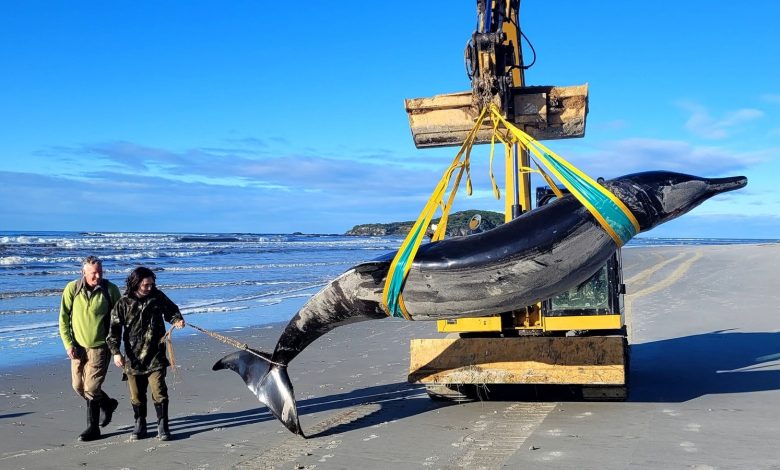Rare whale found washed up on New Zealand beach, unveiling vital clues about species | Trending

With no documented live sightings, spade-toothed whales are the rarest whales in the world. In the enormous expanse of the southern Pacific Ocean, nobody knows where they dwell, what they consume, or even how many there are. However, scients in New Zealand may have finally caught a break. New Zealand Department of Conservation shows rangers Jim Fyfe (L) and Tumai Cassidy walking beside what appears to be the carcass of a rare spade-toothed whale after it was discovered washed ashore on a beach near Taieri Mouth in New Zealand’s southern Otago province. (AFP) The country’s conservation agency said Monday a creature that washed up on a South Island beach this month is believed to be a spade-toothed whale. The five-meter-long creature, a type of beaked whale, was identified after it washed ashore on an Otago beach from its color patterns and the shape of its skull, beak and teeth. “We know very little, practically nothing” about the creatures, Hannah Hendriks, marine technical adviser for the Department of Conservation, said. “This is going to lead to some amazing science and world-first information.” (Also Read: Man adorns buffalo with 10 kg gold chain after making it for a cow, internet reacts) If the cetacean is confirmed to be the elusive spade-toothed whale, it would be the first specimen found in a state that would permit scients to dissect it, allowing them to map the relationship of the whale to the few others of the species found, learn what it eats and perhaps lead to clues about where they live. Only six other spade-toothed whales have ever been pinpointed, and those found intact on New Zealand’s North Island beaches were buried before DNA testing could verify their identification, Hendriks said, thwarting any chance to study them. This time, the beached whale was quickly transported to cold storage and researchers will work with local Māori iwi (tribes) to plan how it will be examined, the conservation agency said. New Zealand’s Indigenous people consider whales a taonga — a sacred treasure — of cultural significance. In April, Pacific Indigenous leaders signed a treaty recognizing whales as “legal persons,” although such a declaration is not reflected in the laws of participating nations. Nothing is currently known about the whales’ habitat. The creatures deep-dive for food and likely surface so rarely that it has been impossible to narrow their location further than the southern Pacific Ocean, home to some of the world’s deepest ocean trenches, Hendriks said. “It’s very hard to do research on marine mammals if you don’t see them at sea,” she said. “It’s a bit of a needle in a haystack. You don’t know where to look.” The conservation agency said the genetic testing to confirm the whale’s identification could take months. It took “many years and a mammoth amount of effort researchers and local people” to identify the “incredibly cryptic” mammals, Kirsten Young, a senior lecturer at the University of Exeter who has studied spade-toothed whales, said in emailed remarks. (Also Read: Man adorns buffalo with 10 kg gold chain after making it for a cow, internet reacts) The fresh discovery “makes me wonder — how many are out in the deep ocean and how do they live?” Young said. The first spade-toothed whale bones were found in 1872 on New Zealand’s Pitt Island. Another discovery was made at an offshore island in the 1950s, and the bones of a third were found on Chile’s Robinson Crusoe Island in 1986. DNA sequencing in 2002 proved that all three specimens were of the same species — and that it was one dinct from other beaked whales. Researchers studying the mammal couldn’t confirm if the species went extinct. Then in 2010, two whole spade-toothed whales, both dead, washed up on a New Zealand beach. Firstly maken for one of New Zealand’s 13 other more common types of beaked whale, tissue samples — taken before they were buried — later revealed them as the enigmatic species. New Zealand is a whale-stranding hotspot, with more than 5,000 episodes recorded since 1840, according to the Department of Conservation.







